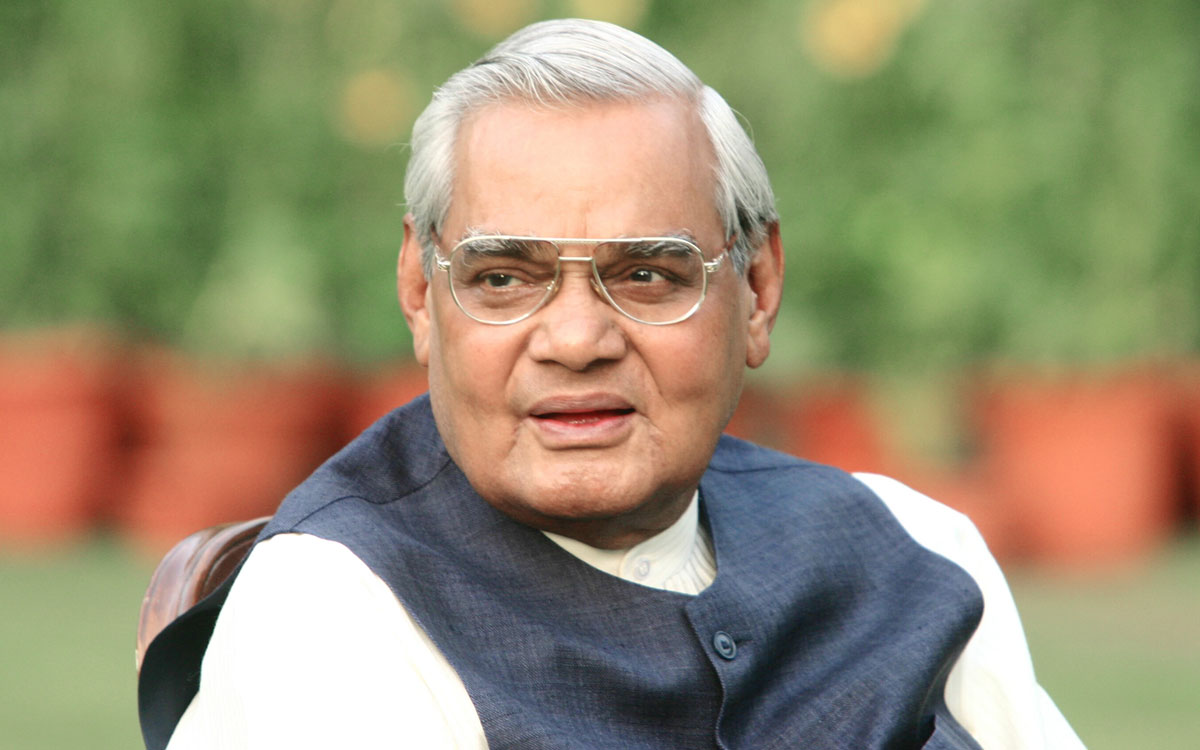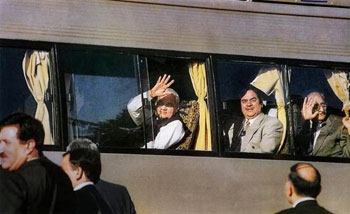The untold Vajpayee
Atal Bihari Vajpayee was born on 25th December 1924 ,Gwalior in Madhya Pradesh, He has done his college from DAV college of Kanpur and then affricated with University of Agra .His profession was as an Writer, Politician and Poet ,He had achieved Padma Vibhushan in 1992 and Bharat Ratna in 2015.
 Atal Bihari Vajpayee was three time Prime Minister of India, first from 16 May to 1 June 1996, and then from 19 May 1998 to 22 May 2004. A member of the Bharatiya Janata Party (BJP), Vajpayee served as the eleventh Prime Minister of India. He headed the BJP-led National Democratic Alliance in the Indian Parliament, and became the first Prime Minister unaffiliated with the Indian National Congress to complete a full five-year term in office. He died at the age of 93 on Thursday 16 August 2018 at 17:05 at AIIMS, New Delhi.
Atal Bihari Vajpayee was three time Prime Minister of India, first from 16 May to 1 June 1996, and then from 19 May 1998 to 22 May 2004. A member of the Bharatiya Janata Party (BJP), Vajpayee served as the eleventh Prime Minister of India. He headed the BJP-led National Democratic Alliance in the Indian Parliament, and became the first Prime Minister unaffiliated with the Indian National Congress to complete a full five-year term in office. He died at the age of 93 on Thursday 16 August 2018 at 17:05 at AIIMS, New Delhi.
After the 1996 general election, the BJP emerged as the single largest party in the LokSabha, the lower house of Parliament. Vajpayee was invited by President Shankar Dayal Sharma to form a government, but after 13 days in office, proved unable to muster a governing majority and resigned. He was replaced by H. D. DeweGowda, leader of the United Front (UF) coalition, and became the Leader of the Opposition.
The United Front was only able to sustain a majority in Parliament until 1998, resigning after the Indian National Congress withdrew its support. In the Indian general election, 1998 the BJP again emerged as the single-largest party, but was able to assemble a governing coalition called the National Democratic Alliance (NDA). Other constituents of the NDA included the All India Anna Dravida Munnetra Kazhagam (AIADMK), Bahujan Samaj Party, Shiv Sena, Shiromani Akali Dal, National Conference (NC) and the Trinamool Congress (TC), amongst others.
By early 1999, the NDA government lost its majority after the AIADMK withdrew its support. President Kocheril Raman Narayanan dissolved the Parliament and called fresh elections – the third in two years. Public anger against smaller parties that jeopardised the NDA coalition and the wave of support for the Vajpayee government in the aftermath of the Kargil War gave the BJP a larger presence in the LokSabha. The NDA won a decisive majority with the support of new constituents such as the Janata Dal (United) and the DravidaMunnetraKazhagam.
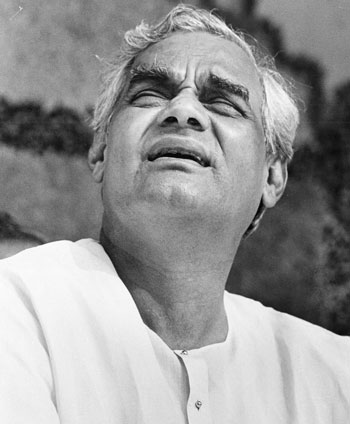 The Vajpayee government expanded the process of economic liberalisation initiated by the P.V. NarasimhaRao government (1991–1996). His government initiated the privatisation of most state corporations, including the Videsh Sanchar Nigam Ltd. His government also began the establishment of special export processing zones, Information Technology and Industrial Parks across the country to bolster industrial production and exports. In its third term (1999–2004), his government launched the National Highway Development Project, with the first phase being the Golden Quadrilateral. In 2003, the government launched the PravasiBharatiyaSamman (Honouring of Non-Resident Indians) and initiated plans to establish an Overseas citizenship of India to enable NRIs to invest and do business freely in India. His government also expanded efforts to encourage foreign investment, especially from Europe and the United States.
The Vajpayee government expanded the process of economic liberalisation initiated by the P.V. NarasimhaRao government (1991–1996). His government initiated the privatisation of most state corporations, including the Videsh Sanchar Nigam Ltd. His government also began the establishment of special export processing zones, Information Technology and Industrial Parks across the country to bolster industrial production and exports. In its third term (1999–2004), his government launched the National Highway Development Project, with the first phase being the Golden Quadrilateral. In 2003, the government launched the PravasiBharatiyaSamman (Honouring of Non-Resident Indians) and initiated plans to establish an Overseas citizenship of India to enable NRIs to invest and do business freely in India. His government also expanded efforts to encourage foreign investment, especially from Europe and the United States.
The Vajpayee government improved India’s ties with the People’s Republic of China, boosting trade and seeking the resolution of territorial disputes through dialogue. India also established strategic and military cooperation with Israel, with both nations establishing cooperation in fighting terrorism. In 2000, U.S. President Bill Clinton became the first American president to visit India since Jimmy Carter. The U.S. and India ended the Cold War-era distant relationship and expanded trade and cooperation on strategic issues. After the 11 September 2001 attacks, India provided much strategic assistance to the U.S. in its war against the Taliban and Al-Qaeda.
Pokhran-II nuclear tests
In May, 1998 India conducted five underground nuclear tests – Pokhran-II, following the Pokhran-I test of 1974. These tests established India as a nuclear weapons power, although it also resulted in the imposition of limited sanctions by the U.S., UK, Canada and other nations. By 2001, most of these sanctions had been lifted.
In 1999, Vajpayee personally travelled to Pakistan on the inaugural Delhi-Lahore Bus, which established a regular road link between the two countries for the first time since 1947. Vajpayee and the then-Pakistani Prime Minister Nawaz Sharif issued the Lahore Declaration, which committed the two nations to resolve bilateral disputes through dialogue and concurrently boost trade.
Why did Vajpayee’s bus diplomacy failed?
‘As events at kargil and pakistan’s continued support to terror activities in India prove, pakistan has always felt that the break up /destruction of India was within its capability,’notes Colonel Anil A Athale(retd).
However, the Lahore sumit’s success was diminished by the outbreak of the Kargil War just months later. In 2001, Vajpayee and Pakistani President Pervez Musharraf held the Agra summit, which failed to produce results and was overshadowed by the 2001-2002 India-Pakistan standoff. In 2003, Vajpayee declared in the Indian Parliament that he was making his final initiative to make peace with Pakistan, and oversaw considerable improvement in relations and a ceasefire between Indian forces and militant groups in the state of Jammu and Kashmir.In 1999, two months after the bilateral summit in Lahore, India discovered that Pakistani army disguised as terrorists had infiltrated through the Line of Control (LOC) into the state of Jammu and Kashmir with active Pakistani assistance and participation. In response, the Indian armed forces launched Operation Vijay to evict the infiltrators. By July, 1999 Indian forces had reclaimed territories on its side of the LOC. The Vajpayee government also established the Defence Intelligence Agency to provide better military intelligence and monitor India’s border with Pakistan.
The terrorist attack on the Indian Parliament building on 13 December 2001, conducted by Lashkar-e-Taiba and Jaish-e-Mohammed terrorists led to the death of a dozen people (5 terrorists, 6 police and 1 civilian) and then 2001-2002 India-Pakistan standoff. In response to these attacks and an escalation in terrorist attacks in other parts of India, the NDA government promulgated the Prevention of Terrorism Act. Although a tougher anti-terrorism law than Terrorist and Disruptive Activities (Prevention) Act, POTA was criticised as compromising civil liberties and encouraging profiling of the Indian Muslim community.[6] As the Rajya Sabha, the upper house of Parliament, was controlled by opposition parties, the Vajpayee government called a historic joint session of both houses of the Indian Parliament in order to enact POTA into law. For all his bravery, perhaps Vajpayee was afraid of younger leaders publicly questioning his authority.
Eight months earlier, in late September 2001, amid massive political infighting, it was decided that Modi would replace Keshubhai Patel as chief minister of Gujarat.
On 1 October, Vajpayee asked Modi to meet him in Delhi, where Modi had lived for the previous three years. Modi had put on weight from the last time they had met. Vajpayee joked about too much ‘Punjabi food’ and then got to business. Modi had to go to Gujarat as CM to prepare the state for the next elections due in 2002.
Vajpayee insisted, because the Keshubhai Patel administration had incurred public wrath over not doing enough for the people of the state after the 2001 earthquake. Some members of the government were in cahoots with unscrupulous builders indulging in shoddy construction. Some of them enjoyed Patel’s patronage.
Modi agreed to accept the CM’s position after being convinced by his mentor Advani to do so. Advani knew about Modi’s lack of administrative experience, but was very fond of him. Finally, Modi was sworn in as chief minister of Gujarat on 7
October 2001.
On 27 February 2002, the Sabarmati Express train was attacked at Godhra by a Muslim mob. 59 Hindu pilgrims returning from Ayodhya were killed in the attack. Lasting for over a month, the riots claimed the lives of more than 1,000 people, mostly Muslims. The state government, led by Narendra Modi of the BJP, was severely criticised for being unable or unwilling to stop the violence.
Vajpayee was accused of doing nothing to stop the violence. He later admitted his mistake in underestimating the violence and not doing enough to stop it.
K.R. Narayanan, then president of India, stated that the violence stemmed from a “conspiracy” between Vajpayee’s central BJP-led government, and Gujarat’s BJP government. Narayanan said he wrote several letters to Vajpayee asking him deploy the Indian army to quell the violence. Narayanan didn’t speak out against Vajpayee during his term as president, as the Indian Constitution permits the president to speak only with the permission of the Prime Minister.
Modi has to go’: Post-2002 Gujarat riots, Atal Bihari Vajpayee wanted then CM to step down
Atal Bihari Vajpayee, one of the shrewdest politicians of India, is known for negotiating multiple paradoxes: from militant nationalism to his secret family life; his stint as a communist; his indulgence in food; and his attempt to project himself as a moderate, if not a liberal. Exploring crucial milestones of Vajpayee’s career and his traits as a seasoned politician, looks at his relationship with leaders of his party and his love–hate association with the RSS and its feeder organisations. The Untold Vajpayee will open a window to the life and times of a poet-politician.
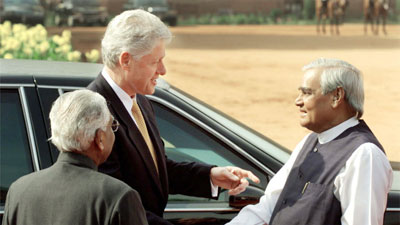 On 27 February 2002, a group of people from a Muslim populated area of Godhra had set fire to a few bogies of a train — the Sabarmati Express — which carried pilgrims from Ayodhya, a town considered holy by the Hindus. Massive riots broke out, mostly targeting Muslims, for nearly a week.
On 27 February 2002, a group of people from a Muslim populated area of Godhra had set fire to a few bogies of a train — the Sabarmati Express — which carried pilgrims from Ayodhya, a town considered holy by the Hindus. Massive riots broke out, mostly targeting Muslims, for nearly a week.
name, the more so because Gujarat had a BJP government All the killing and pillaging in Gujarat had given Vajpayee a bad in place, with a chief minister who had reportedly not risen enough to the occasion to rein in the violence. Vajpayee was blamed for his failure as PM to get rid of Chief Minister Narendra Modi, who reportedly shouted back at a Muslim leader on the phone for seeking help after a mob had gathered outside his house. Some hours later, the Muslim leader was launched, and Modi is alleged to have asked the police forces to let the violence continue. At that moment, Modi seemed to be the villain who brought a lot of shame to the central government.
Modi had also dared to publicly snub Vajpayee at a press conference where he was seated alongside the prime minister. The reporter wanted to know Vajpayee’s message for the chief minister in the wake of the riots. In controlled displeasure, Vajpayee stated that Modi should ‘follow his Rajdharma’. He explained that Rajdharma was a meaningful term, and for somebody in a position of power, it meant not discriminating among the higher and lower classes of society or people of any religion.
Three days before his foreign tour in April, when Vajpayee visited the Shah Alam camp in Ahmedabad, which housed 9,000 Muslims displaced by the riots, he was deeply touched when a woman told him that he alone could save them from the hell that their lives had become. Now, on the flight to Singapore, Vajpayee was worried he would expose himself to more humiliation while outside the country. His grouse was: why am I being paraded abroad at such a time?
Shourie suggested that the PM speak to Advani, who had by now become the deputy prime minister, about the possibilities of salvaging the situation — it could even mean replacing Modi. But even after the ‘pep talk’ with Shourie, Vajpayee appeared cheerless. He told Shourie that he would speak to Advani about it.
They reached Singapore; there were no meetings scheduled for the first day. The next day there were several engagements, including ceremonial visits to dignitaries, which included the former ruler Lee Kuan Yew. The Gujarat issue came up in an interview on the third and final day of their stay in Singapore. The journalist who interviewed Vajpayee first stated that Singaporeans were wary of communal disturbances, clearly indicating that he was referring to the recent riots in Gujarat, under the BJP rule. Then he shot off his question:
‘And in India such disturbances have happened not once, but several times. In this regard what can Singapore learn from India’s experience and what can you share?’
Vajpayee paused and rubbed his forehead… before answering, betraying a level of discomfiture in answering questions related to the Gujarat riots. Then, weighing his words, he said, ‘Whatever happened in India was very unfortunate. The riots have been brought under control. If at the Godhra station, the passengers of the Sabarmati Express had not been burnt alive, then perhaps the Gujarat tragedy could have been averted. It is clear there was some conspiracy behind this incident. It is also a matter of concern that there was no prior intelligence available on this conspiracy. Alertness is essential in a democracy. We have been cautious. And if one does not ignore even small incidents like one used to in the past, then one will certainly be successful in fighting terrorism.’ Clearly, he was on the defensive, and the issue worried him no end.
It was Vajpayee who had asked Modi to take over as Gujarat chief minister. Before the delegation left for Cambodia that day, Shourie asked Vajpayee whether he had a chat with Advani. The prime minister looked distraught, but answered that he had not yet had a word on the matter with Advani, Modi’s mentor.
On the same day, 9 April, Vajpayee met the Cambodian prime minister, Hun Sen, and other officials. He also made ceremonial speeches at Phnom Penh. Over the next two days, the prime minister signed various pacts with his Cambodian counterpart, and announced that India would offer 10,000 tonnes of rice for distribution among the people of Cambodia, especially among the flood-hit. He also visited the famous Angkor Wat temple, where Shourie again found Vajpayee to be distracted and lost in thought. He asked Vajpayee again if he had spoken with Advani, and he answered in the negative. The Indian delegation led by Vajpayee returned on 11 April. The next day, senior BJP leaders were to attend a national executive meet in Goa.
Shourie went home and took a shower. He was reading a book when he got a call from Brajesh Mishra asking if he had booked tickets to Goa. Shourie said he had. ‘Please cancel them. You are going with the PM and the deputy PM in the PM’s aircraft,’ Mishra said, emphasising that if he didn’t go, both Vajpayee and Advani would not talk if they were left alone in a plane.
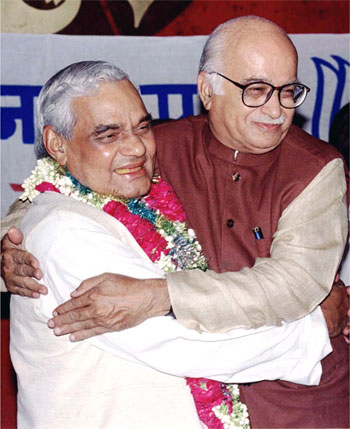 When Shourie boarded the plane, Vajpayee was already there, seated next to the window, and facing him, across a table, on a window seat was Advani. The external affairs minister, Jaswant Singh, was also there.
When Shourie boarded the plane, Vajpayee was already there, seated next to the window, and facing him, across a table, on a window seat was Advani. The external affairs minister, Jaswant Singh, was also there.
The plane took off and after a few minutes, Vajpayee took a newspaper from the table in front of him and opened it so widely that he didn’t have to face Advani at all. A little while later, Advani also picked up a newspaper and began to read. Shourie and Singh looked at each other and sighed.
Then Shourie surprised himself. He pulled the newspaper out of Vajpayee’s hands and interjected, ‘Vajpayee, newspapers can be read later also. Why don’t you tell Advani ji what you wanted to tell him?’ Vajpayee kept the newspapers away, and muttered in his usual style about what had to be done. First, Venkaiah Naidu would replace Jana Krishnamurthy as BJP president. Then he said, ‘Modi has to go.’ By the time they landed in Goa, the decision was taken: Modi would go.


